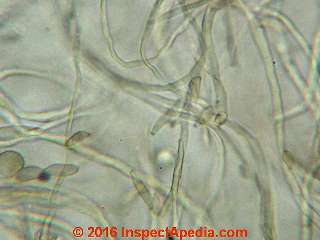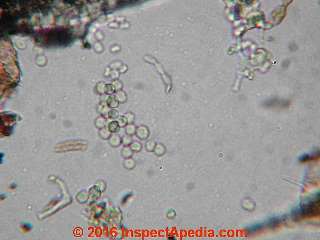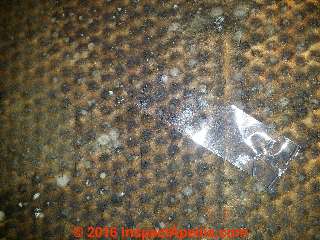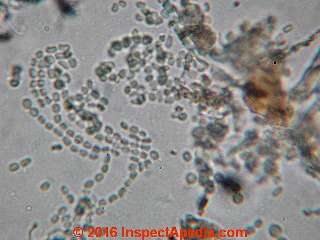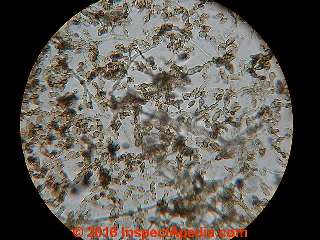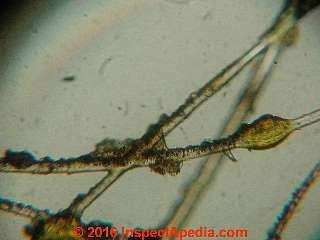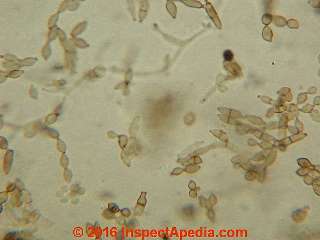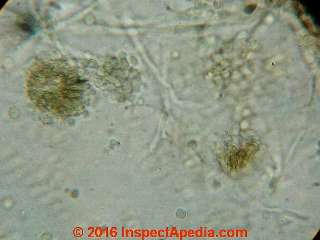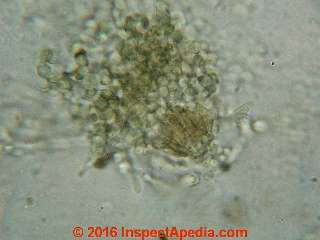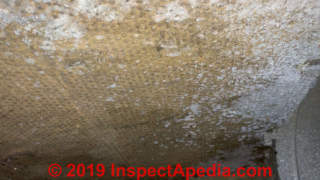 Fiberglass HVAC Duct Mold Test Results
Fiberglass HVAC Duct Mold Test Results
- POST a QUESTION or COMMENT about Mold in Air Ducts: cause, detection, cure, & prevention of moldy HVAC ductwork
How to inspect & test air ducts for mold contamination:
Visual inspection followed by a simple adhesive tape test confirmed mold growth inside the fiberglass-lined HVAC duct shown here.
This article describes how to test the surface of fiberglass-lined or fiberglass-panel air ducts for the presence of problem mold growth. While some debris and low levels of mold, pollen and other particles is normal inside HVAC systems, large areas of harmful mold genera such as Aspergillus or Penicillium may be hazardous to building occupants.
This article series explains the cause, detection, and hazards of mold growth in fiberglass insulation in residential and light-commercial building and gives advice about dealing with moldy building insulation or ductwork. We describe the types (genera/species) of mold most often found in HVAC ducts and the relationship between mold in ductwork and indoor air quality complaints by building occupants. We include authoritative citations for key research on mold contamination in HVAC ductwork.
InspectAPedia tolerates no conflicts of interest. We have no relationship with advertisers, products, or services discussed at this website.
- Daniel Friedman, Publisher/Editor/Author - See WHO ARE WE?
Water Leaks & Mold Contamination in Fiberglass HVAC Duct Interiors
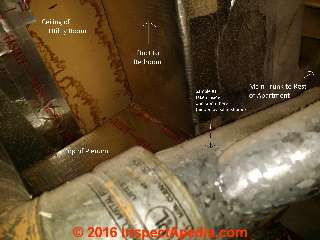 Here we discuss and illustrate inspection of air ducts for mold contamination following signs of leaks and suspected mold.
Here we discuss and illustrate inspection of air ducts for mold contamination following signs of leaks and suspected mold.
Mold may grow at extensive or problematic levels in some building insulation materials used in walls, floors, ceilings as well as in HVAC air duct systems.
[Click to enlarge any image]
Above: leak stains may point to sources of water entry into a building's HVAC duct system that in turn can trigger problematic or harmful mold growth and contamination of the duct system.
These stains combined with visible mold inside a fiberglass-panel air duct and plenum (below) lead a reader to collect surface samples of suspected mold contamination for analysis in our laboratory.
Below we describe the test samples and the lab results finding large areas of several genera of mold contaminants.
Photo below: white, gray, light green round-like deposits on the interior of fiberglass HVAC ducts look like a substantial area of mold contamination. Mold test tape sample locations were chosen specifically to attempt to capture mold-suspect material in these locations on the ductwork fiberglass liner surface.
In the laboratory we found that the white, gray, and light-green fuzzy round spots on the HVAC duct interior in this photograph were indeed several genera/species of mold.
Really? Well yes, it's mold. Just how much of a health hazard is posed by the mold in the photograph is questionable. But the samples and building case history support a couple of warnings:
- High airborne levels of the mold found in these tests would be hazardous to building occupants and might occur if there is in fact a larger mold reservoir in the HVAC system or elsewhere in the building.
- Wet or moldy conditions that produced the mold found and tested here might indeed also have invited a problem mold reservoir elsewhere in the building.
- Further investigation is warranted. Details are below.
Photo below: white, gray, light green round-like deposits on the interior of fiberglass HVAC ducts.
The shape of these spots and color suggests they might be mold contamination but other possibilities such as drywall debris were also under consideration. The dark, regularly-spaced gray "spots" are natural deposits of house dust (and possibly contaminants" on the factory-surface of the fiberglass duct liner.
Question: are these white splotches on the interior of my fiberglass lined ductwork mold or drywall dust or something else?
I recently leased an apartment a few miles northwest of Atlanta, GA, and have been trying to track down the source of the combination of odors permeating the apartment. The apartment manager is not being very helpful. As I inspected the ductwork, I came across a substance which looks like it could be mold. Pictures are attached. I thought at the very least, you might be interested in using the pictures on your website, whether on the "white mold" page or the "not mold" page.
If you have the time, I would also appreciate your opinion on whether this warrants calling in a mold expert or if it just looks like dirt or debris to you (perhaps drywall dust?). The zoomed out picture shows the view as I insert the camera about 18 inches into the bedroom register towards the plenum (visible on the left) and the main trunk (extending towards the right).
Two other pictures [not displayed here - Ed] show what I suspect to be mold (one on the floor of the main trunk, the other on the wall where the bedroom branch hits the main trunk (just outside the zoomed-out picture).
The apartment is 20-odd years old, though according to maintenance the HVAC system was replaced about 10 years ago. For all I know the ductwork could be original.
The sampling area where these mold photographs and samples were taken is described thus:
- Visible mold-like substances growing in the HVAC system air plenum and in nearby ductwork
- Water lines in the utility/maintenance room suggest leaks from the floor above at some prior time
- Water stains are visible on the wall, ceiling, and outside foil surface of the HVAC ducts
- 2016/11/05 Anonymous by private email
Reply: Procedure for detection & identification of Aspergillus sp. & Penicillium sp. as well as significant amounts of Cladosporium sp. as well as low levels of other molds and particles on these fiberglass duct interior surfaces
The white splotches in your photos look very much like small whitish mold colonies. On magnification one can see the characteristic center color and mounding and growth outwards from that point. We see such round-ish mold colonies when a single spore lands on a surface whereon it finds hospitable growing conditions.
In HVAC ducts I imagine that the mold growth would be due to a combination of organic debris in dust stuck to the fiberglass surface (house dust contains skin cells and other organics) and moisture.
Regrettably I'm not optimistic about disinfection nor cleaning of mold contaminated fiberglass hvac ducts. If the total area were just a few inches I'd probably wipe gently or spray with a household disinfectant/cleaner and blot gently and then concentrate on addressing the controllable causes: filtration of the return air and control of moisture.
For large areas - many square feet or more, and for homes where occupants are at extra risk: elderly, immune compromise, asthmatic, infant, etc., I'd probably replace the ductwork.
While fiberglass is an excellent insulating and noise control material, because of these cleaning difficulties I prefer metal ductwork with insulation on its exterior. IF conditions are bad enough that you decide to replace some duct sections I'd consider that change.
At TEST KIT for DUST, MOLD, PARTICLES: INSTRUCTIONS you can see how to use clear adhesive tape and a freezer-type ziplok bag to collect suspected mold samples.
When this test procedure is being used to screen for mold, the location selected for testing is very important: it should be representative of the largest or most-likely dominant mold or suspect-particle reservoir, chosen by location, size, and other visual properties.
Duct Surface Test Lab Analysis Results: observations of tape samples of suspected mold inside fiberglass HVAC ductwork
[Click to enlarge any image] Above: sample 1 mold test location on the floor of the HVAC duct. Click to enlarge to see the position of the adhesive tape used to collect this mold test sample.
Fiberglass-lined HVAC Duct Sample #1 sample information
- Sample date/time: 11/7/2016, 2:00 AM
- Location: bottom (floor) of the duct just beyond where bedroom duct opens into the supply plenum ("cavern") above the HVAC unit. Multiple colors of mold-suspect material present.
- Building location: Smyrna GA 30080 USA
- Building owner/occupant: anonymous, by private email
Fiberglass-lined HVAC Duct Mold Test Sample Results
Above first photo: sample 1, Cladosporium sp. fungal spores and hyphal fragments. These conditions confirm active fungal growth. This is not simply an air deposit of mold spores.
Above second photo, sample 1, hyaline (colorless) spores and spore chains, generically "Amerospores" but more likely Pen/Asp spores in this sample. Other unidentified mold spores. Hyphal fragments. Typical indoor dust debris. Pen/Asp spores in chains confirm nearby fungal growth of one or both of these mold genera.
Fiberglass-lined HVAC Duct Sample #2 sample information
Above: sample 2 mold test location on the upper surface of the interior of the HVAC duct.
[Click to enlarge any image]
- Location: from "ceiling" of "cavern" a few more inches further inside with respect to sample #1; mold less dense; well-defined clusters, at least one of which has light-gray or white fringes and a darker gray (slight greenish-tint) center.
- Sample date/time: 11/7/2016, 2:00 AM
Fiberglass-lined HVAC Duct Mold Test Sample Result Conclusions
In the two mold samples on adhesive tape we found evidence of the following molds:
- Penicillium/Aspergillus spores in long spore chains consistent with active nearby fungal growth.
- Aspergillus sp. conidiophores and mold spores
- Cladosporium sp. - very common in building air handlers and ductwork, commonly allergenic. Occasionally pathogenic.
- Penicillium sp. conidiophores and mold spores
- Trichoderma-like fungal spore clusters.
- Wallemia-like fungal spore chains.
Lab photos of these duct mold test findings and observations are provided in this article.
Warnings: When Aspergillus or Penicillium spores are present in chains in indoor mold samples we can be confident that there is active fungal growth of these mold genera. When the conidiophores (mold producing growth structures) are present it is possible to separate the identification these two genera.
In these samples we found both types of conidiophores. At high levels in building air either of these two mold genera are potentially serious health hazards.
Without a more extensive inspection of the building and its HVAC systems and ductwork to determine the total extent of mold growth by area and type, we cannot conclude the level of actual health hazard to building occupants. I recommend that further inspection of the building and its HVAC system be performed.
[Click to enlarge any image]
Above first photo, sample 1, long hyaline spore chains, Wallemia serbi-like but possibly desiccated Pen/Asp spores. Other typical indoor air debris.
Above second photo sample 1, dense profusion of Cladosporium sp. fungal spores and some hyphal fragments.
Above first photo, sample 1, typical fiberglass fibers with dark debris, normal in indoor fiberglass duct surfaces.
Above second photo sample 1, Cladosporium sp. fungal spores and some hyphal fragments.
Other photographs illustrating the appearance of white or light colored mold in buildings are
Above first photo, sample 1, Aspergillus-like conidiophore and hyphae at upper left, Penicillium-like conidiophore at lower right.
Above second photo sample 1, Penicillium sp. conidiophore.
Above first photo, sample 2, Aspergillus sp. conidiophore (photo center) hyphae (photo upper left).
Above second photo sample 2, Cladosporium sp. in dense fungal growth on the surface.
What to do about mold contamination in ductwork
Watch out: The reader's photos showing the duct interior looks very moldy over more than just a trivial area; it's likely that this is itself a significant mold reservoir and of course there may be hidden mold on the cavity side of drywall that got wet from the leaks you show.
Large reservoirs of Aspergillus sp., possibly Penicillium sp. and possibly Cladosporium sp. (depending on the species in this case) are likely to be health hazards to building occupants, can even healthy non-allergic people to become sensitized to mold, and for people who are asthmatic, allergic, immune impaired, elderly, infant, or otherwise at risk for respiratory illness, such mold contamination can be a serious hazard.
The type of ductwork in these photos, fiberglass-panel constructed ducts (as well as any fiberglass lined ducts) cannot be effectively cleaned by conventional duct cleaning methods - most likely the ductwork needs to be replaced. But before risking contaminating new ductwork with airborne moldy dust, the building merits further investigation.
Please see DUCT CLEANING ADVICE for guidance on cleaning mold-contaminated HVAC ductwork.
Question: any lawsuits or class action over HVAC insulating duct boards?
(Aug 26, 2014) Maggie said:
Are there any type of lawsuits for duct boards?
Insurance won't pay anything for the remediation of my home and I am at a loss on where to even start - no one seems to be able to tell me the source of my leak or what has caused the contamination or how long I've had the mold growth and I am now being told my whole house needs to be remediated because it's blown throughout the duct work for who knows how long and the levels are off the charts
Reply:
Maggie,
I'm doubtful that lawsuits are the best place to start attacking the problem you describe. I'd start by hiring either an experienced building inspector or HVAC system technician to diagnose the problem you face, including its cause, providing evidence and documentation, not just "opinion" lest you get nowhere. If necessary you may need an independent insurance adjuster to help out.
From just your note we don't know what contamination is the concern, nor how we know what's been blown through the building, at what levels, and causing what need for further cleaning.
(Aug 26, 2014) Anonymous said:
Thanks Dan. I have actually had all the mold testing along with air samples done and that's how I know it's all throughout my house. I have the type of mold and the counts etc. The insurance adjuster is coming to see if there's any possibility of them paying for any of it - but they say there's slim to no chance of them paying for any of it and if they do it is a minimal amount of the cleanup.
I am in the process of getting estimates from 3 mold remediation companies and an estimate from a HVAC company for replacement of the duct board and/or whole system. I spoke to a real estate agent about "resale" values and the effect of mold in the home and he is actually the one who suggested researching if there were any lawsuits relating to duct boards since insurance doesn't pay for anything etc. I did a google search but came up with nothing. The cost is very prohibitive to wanting to get your house clean so it's all pretty discouraging.
Reply:
If your HO policy excludes mold damage you're not covered.
WATCH OUT: DO NOT allow a superficial inexpert "cleanup" if in fact there is a large area of mold contamination - inexpert work may further spread contamination and require still more professional and costly cleanup. Before proceeding with cleanup you need a reliable mold remediation plan defining the scope of work, containment, etc.
(Aug 27, 2014) Maggie said:
Yes the insurance company came out today to do their inspection and nothing is covered. I have 4 companies coming tomorrow to provide me with quotes. Two of them work with insurance companies all the time and are supposed to be two of the top mold removal companies (Rainbow Intl and ServPro) the other is Advanta and the 4th is AAS Restoration. If you've heard of any of these companies and have any reviews or thoughts on them I would appreciate any feedback. I've read Angies list reviews and other online reviews and really haven't seen too many bad reviews on any of them.
I also had a duct cleaning service come in that was NADCA certified and they were telling me about some type of service that they spray and paint and the manufacturer of the product guarantees no new regrowth or old leaks of mold for 10 years. I'm guessing this would be the cheapest but not sure if it is the most effective.
If you have an opinion on that too I would appreciate your input. ServPro also told me they use a different testing company because the mold inspection company I used tends to be very "over the top" with their recommendations. For instance because my readings on the 3rd floor were high they suggested having the whole house HEPA vaccumed. ServPro suggested the whole house may not require "total cleaning"
He stated some companies will then try to tell you you have to have absolutely everything cleaned or thrown away - like sheets, clothes and if you have a stuffed animal it would be thrown away. Tables could be cleaned but some furniture couldn't - so sometimes the "over the top" recommendations are not necessary and companies may try to get me to do more than necessary.
Not sure if you have thoughts on that either but if I do the minimum cleaning - in other words replace duct work clean extremely high level areas with HEPA vacuuming etc. how much damage will I leave if I don't HEPA clean whole house. I of course realize these are all broad opinions on items that you are not seeing or reports you are reading. Thank.
Reply: "throw everything away" is usually inappropriate advice
I agree with your ServPro rep that "throw everything away" is usually inappropriate advice. Some items such as hard surface items are usually easily cleaned; some soft goods can be laundered or dry cleaned. Other items such as water damaged carpets, padding, drywall, upholstered couches are tossed out.
Question: white dust in fiberglass HVAC ducts: Efflorescence?
Hi - reading a lot on this website as we are renters in a 3-level (w/ HVAC unit in 4th level crawl space) town home in NC. I independently hired an air duct cleaning service, since I noticed that we were still wiping dust off of surfaces following some drywall repair and I have bad allergies.
The cleaning never started though, since the guy went up to the unit, looked inside the plenum box and suspects there is mold/other growth that needs to be remediate before cleaning can be done.
Couple of things/prior events to keep in mind:
Approx 6 months ago: HVAC utility drain clogged and was running over for a few weeks. We only picked it up due to a leak down on the 1st floor that was coming through drywall.
Approx 3 months ago: ServPro brought in to remove damaged drywall and bring in dryer fans. Drywall was replaced and sanded and painted (hence the dust mentioned above).
Approx 1 month ago: noticed another leak on 1st floor. This one resulted in replacement of HVAC system (coils were dirty, lines freezing over thus causing leak).
This week: duct cleaning service came out but could not proceed further. HVAC company that installed new unit came out and looked at plenum box, saying it is probably efflorescence growing in the fiberglass box due to sediment from the water that runs through the unit. Unit is on 4th floor, in an unconditioned crawl space so during summer months it is hot and humid up there.
I welcome your thoughts on situation and whether you’d recommend a test for mold. Property manager is slow to act, and given I have allergies (esp to mold), I don’t want to just sit around and wait. Photos also attached.
On 2019-07-13 Reply by (mod) -
It's not efflorescence. That conclusion tells us that the person asserting that is not well informed.
Efflorescence is a mineral salt left behind when water leaches through *masonry* materials such as brick, concrete, stone as water, passing through the masonry, dissolves minerals, then evaporates from the surface, leaving minerals behind.
See EFFLORESCENCE SALTS & WHITE DEPOSITS if you want to know more about that - but it has *nothing* to do with HVAC ducts.
If there was drywall work including sanding, and if the HVAC system air handlers were running during that time, it'd be no surprise to find white gypsum dust deposits in the ductwork, supply and return plenums, and on the blades of the blower fan.
Unfortunately, fiberglass lined ducts cannot be physically cleaned - trying to do so damages the fiberglass surface and ruins it, causing subsequent fiberglass shedding, a small reduction in air flow and increased rate of particle trapping.
Gypsum dust alone trapped in the ductwork isn't particularly dangerous. That same dust (or other dirt) could explain clogging of condensate drains that led to leaks - something worth investigating.
IF the duct interiors have been wet then the combination of water + organic dust and debris normally found on duct surfaces (principally skin cells and fabric fibers) invites mold growth. If mold is growing in / on fiberglass ducts the cause needs to be corrected, the air handler cleaned, and the ducts replaced. (They cannot be cleaned, and in my experience and opinion, magic-bullet spray coatings are unreliable).
If you see other material than what's obvious drywall dust and suspect it's mold, collect a tape sample for lab analysis.
See TAPE & BULK SAMPLING & TESTS for MOLD to see how easily that's done.
I would not have "air tests" done - as that approach is highly inaccurate and also not diagnostic. If you want to know more about that problem
see AIRBORNE PARTICLE COUNTS in DUCTWORK.
Finally, when there have been leaks wetting building materials, particularly ones that may be mold friendly such as insulation, drywall, wood, the investigator who defines the presence of a problem needing attention also needs to define the scope of work, the extent of cleanup needed, and after the work is done, that person, who must be independent of the company doing the work, confirms that the cleanup was complete and the problem cause found and fixed.
Mold-Contaminated Fiberglass Duct Research
Help for detecting & testing mold contamination in HVAC ductwork.
- SHOULD YOU HAVE THE AIR DUCTS IN YOUR HOME CLEANED [PDF], U.S. Environmental Protection Agency, Indoor Environments Division, EPA-402-K-97-002, web search 8/5/11, original source: http://www.epa.gov/iaq/pdfs/airducts.pdf
- INDOOR MOLD AND HEALTH, A FUNGUS AMONG US [PDF], Florida State Department of Health, Florida Department of Health
Division of Environmental Health
Bureau of Community Environmental Health
Radon and Indoor Toxics
4052 Bald Cypress Way, Bin A08
Tallahassee, FL 32311
1-850-245-4288
1-800-543-8279, web search 08/05/2011, original source: http://www.doh.state.fl.us/environment/community/indoor-air/Indoor_Mold_and_Health.pdf. Quoting:
The Florida Department of Health has developed this brochure to address some of the most common questions and concerns about indoor mold, how it affects human health, and ways in which you can prevent or remove it. - Ahearn, D.G., S A Crow, R B Simmons, D L Price, J A Noble, S K Mishra and D L Pierson, "Fungal colonization of fiberglass insulation in the air distribution system of a multi-story office building: VOC production and possible relationship to a sick building syndrome", Journal of Industrial Microbiology & Biotechnology, Volume 16, Number 5 (1996), 280-285, DOI: 10.1007/BF01570035. Abstract:
Complaints characteristic of those for sick building syndrome prompted mycological investigations of a modern multi-story office building on the Gulf coast in the Southeastern United States (Houston-Galveston area). The air handling units and fiberglass duct liner of the heating, ventilating and air conditioning system of the building, without a history of catastrophic or chronic water damage, demonstrated extensive colonization with Penicillium spp and Cladosporium herbarum.
Although dense fungal growth was observed on surfaces within the heating-cooling system, most air samples yielded fewer than 200 CFU m–3. Several volatile compounds found in the building air were released also from colonized fiberglass.
Removal of colonized insulation from the floor receiving the majority of complaints of mouldy air and continuous operation of the units supplying this floor resulted in a reduction in the number of complaints. - [6] Ahearn, D.G., S.A. Crow, R.B. Simmons, D.L. Price, S.K. Mishra and D.L. Pierson, "Fungal Colonization of Air Filters and Insulation in a Multi-Story Office Building: Production of Volatile Organics", Current Microbiology Volume 35, Number 5 (1997), 305-308, DOI: 10.1007/s002849900259, Abstract:
Secondary air filters in the air-handling units on four floors of a multi-story office building with a history of fungal colonization of insulation within the air distribution system were examined for the presence of growing fungi and production of volatile organic compounds. Fungal mycelium and conidia of Cladosporium and Penicillium spp. were observed on insulation from all floors and both sides of the air filters from one floor.
Lower concentrations of volatile organics were released from air filter medium colonized with fungi as compared with noncolonized filter medium.
However, the volatiles from the colonized filter medium included fungal metabolites such as acetone and a carbonyl sulfide-like compound that were not released from noncolonized filter medium. The growth of fungi in air distribution systems may affect the content of volatile organics in indoor air. - Ahearn, D. G., S. A. Crow, R. B. Simmons, D. L. Price, J. A. Noble, S. K. Mishra, and D. L. Pierson. "Fungal colonization of fiberglass insulation in the air distribution system of a multi-story office building: VOC production and possible relationship to a sick building syndrome." Journal of Industrial Microbiology 16, no. 5 (1996): 280-285.
Abstract:
Complaints characteristic of those for sick building syndrome prompted mycological investigations of a modern multi-story office building on the Gulf coast in the Southeastern United States (Houston-Galveston area).
The air handling units and fiberglass duct liner of the heating, ventilating and air conditioning system of the building, without a history of catastrophic or chronic water damage, demonstrated extensive colonization withPenicillium spp andCladosporium herbarum. Although dense fungal growth was observed on surfaces within the heating-cooling system, most air samples yielded fewer than 200 CFU m−3.
Several volatile compounds found in the building air were released also from colonized fiberglass. Removal of colonized insulation from the floor receiving the majority of complaints of mouldy air and continuous operation of the units supplying this floor resulted in a reduction in the number of complaints. - Ahearn DG, DL Price, RB Simmons and SA Crow Jr. 1992. Proceedings of colonization studies of various HVAC insulation materials. In: IAQ 92 Environments for People, pp 179–183, American Society of Heating Refrigeration and Air Conditioning Engineers, Inc, Atlanta, GA.
- Ahearn DG, RB Simmons, KF Switzer, L Ajello and DL Pierson. 1991. Colonization byCladosporium spp of painted metal surfaces associated with heating and air conditioning systems. J Ind Microbiol 8: 277–283.
- Bayer CW and SA Crow. 1993. Odorous volatile emissions from fungal contamination. In: IAQ 93 Environments for People, pp 99–104, American Society of Heating Refrigeration and Air Conditioning Engineers, Inc, Atlanta, GA.
- Burge HA, A Hedge, S Wilson, JH Bass and A Robertson. 1987. Sick building syndrome: a study of 4373 office workers. Ann Occup Hyg 31: 493–504.
- Pasanen P, A Pansanen and M Jantunen. 1993. Water condensation promotes fungal growth in ventilation ducts. Indoor Air 3: 106–112.
- [7] Price,D. L., R. B. Simmons, I. M. Ezeonu, S. A. Crow and D. G. Ahearn, "Colonization of fiberglass insulation used in heating, ventilation and air conditioning systems", Journal of Industrial Microbiology & Biotechnology Volume 13, Number 3 (1994), 154-158, DOI: 10.1007/BF01584000,
Abstract:
The number of fungal species colonizing thermal and acoustic fiberglass insulations used in heating, ventilation, and air conditioning (HVAC) systems was fewer than that obtained from initial direct culture of these insulations.
The colonization, determined by the microscopic observation of conidiophores with conidia, was primarily of acrylic-latex-facing material, but eventually the fungi permeated the fiberglass matrix. Isolates of Aspergillus versicolor were most often obtained from non-challenged insulation, whereas Acremonium obclavatum appeared to be the primary colonizing fungus in high-humidity (>90%) challenge chambers.
At a lower humidity (about 70%) Aspergillus flavus was one of the more prominent fungi. Not all duct liner samples were equally susceptible to colonization and duct board appeared relatively resistant to colonization. - Price DL, IM Ezeonu, RB Simmons, PR Morey and DG Ahearn. 1995. Fungal colonization and water activity studies of heating ventilating and air conditioning system insulation materials from a sick building. In: Indoor Air-An Integrated Approach Morawska L, ND Bofinger and R Maroni, eds, pp 321–324, Elsevier Science, Oxford.
- Price DL, RB Simmons, IM Ezeonu, SA Crow and DG Ahearn. 1994. Colonization of fiberglass insulation used in heating, ventilation and air conditioning systems. J Ind Microbiol 13: 154–158.
- Simmons RB and SA Crow. 1995. Fungal colonization of air filters for use in heating, ventilating, and air conditioning (HVAC) systems. J Ind Microbiol 14: 41–45.
- Also seeReferences or Citations at the end of this page
...
Continue reading at WHY DOES MOLD GROW in INSULATION? or select a topic from the closely-related articles below, or see the complete ARTICLE INDEX.
Or see these
Recommended Articles
- AIRBORNE PARTICLE & MOLD LEVELS in DUCTWORK where we describe how to test HVAC systems and ductwork for mold.
- BLOWER LEAKS, RUST & MOLD for Readers concerned with mold contamination in heating and air conditioning air handlers and ductwork
- DUCT CLEANING ADVICE
- DUCT DAMAGE, MECHANICAL
- FIBERGLASS HAZARDS
- FIBERGLASS INSULATION MOLD - home
- MOLD APPEARANCE - WHAT MOLD LOOKS LIKE for help in recognizing what mold looks like in buildings.
- MOLD APPEARANCE - STUFF THAT IS NOT MOLD for examples of stuff sometimes mistaken for mold
- MOLD GROWTH in AIR HANDLERS
- TAPE & BULK SAMPLING & TESTS for MOLD on how to use tape to sample settled dust or suspected mold growth.
- WHY DOES MOLD GROW in INSULATION?
Suggested citation for this web page
FIBERGLASS AIR DUCT MOLD TEST at InspectApedia.com - online encyclopedia of building & environmental inspection, testing, diagnosis, repair, & problem prevention advice.
Or see this
INDEX to RELATED ARTICLES: ARTICLE INDEX to MOLD CONTAMINATION & REMEDIATION
Or use the SEARCH BOX found below to Ask a Question or Search InspectApedia
Ask a Question or Search InspectApedia
Try the search box just below, or if you prefer, post a question or comment in the Comments box below and we will respond promptly.
Search the InspectApedia website
Note: appearance of your Comment below may be delayed: if your comment contains an image, photograph, web link, or text that looks to the software as if it might be a web link, your posting will appear after it has been approved by a moderator. Apologies for the delay.
Only one image can be added per comment but you can post as many comments, and therefore images, as you like.
You will not receive a notification when a response to your question has been posted.
Please bookmark this page to make it easy for you to check back for our response.
IF above you see "Comment Form is loading comments..." then COMMENT BOX - countable.ca / bawkbox.com IS NOT WORKING.
In any case you are welcome to send an email directly to us at InspectApedia.com at editor@inspectApedia.com
We'll reply to you directly. Please help us help you by noting, in your email, the URL of the InspectApedia page where you wanted to comment.
Citations & References
In addition to any citations in the article above, a full list is available on request.
- [3] Mark Cramer Inspection Services Mark Cramer, Tampa Florida, Mr. Cramer is a past president of ASHI, the American Society of Home Inspectors and is a Florida home inspector and home inspection educator. Mr. Cramer serves on the ASHI Home Inspection Standards. Contact Mark Cramer at: 727-595-4211 mark@BestTampaInspector.com 11/06
- [8] Simmons, R. B. and S. A. Crow, "Fungal colonization of air filters for use in heating, ventilating, and air conditioning (HVAC) systems", Journal of Industrial Microbiology & Biotechnology Volume 14, Number 1 (1995), 41-45, DOI: 10.1007/BF01570065, Abstract:
New and used cellulosic air filters for HVAC systems including those treated with antimicrobials were suspended in vessels with a range of relative humidities (55–99%) and containing non-sterile potting soil which stimulates fungal growth. Most filters yielded fungi prior to suspension in the chambers but only two of 14 nontreated filters demonstrated fungal colonization following use in HVAC systems. Filters treated with antimicrobials, particularly a phosphated amine complex, demonstrated markedly less fungal colonization than nontreated filters. In comparison with nontreated cellulosic filters, fungal colonization of antimicrobial-treated cellulosic filters was selective and delayed. - [9] Ifeoma M. Ezeonu, Daniel L. Price, Sidney A. Crow and Donald G. Ahearn, "Effects of extracts of fiberglass insulations on the growth of Aspergillus fumigatus and A. versicolor", Mycopathologia Volume 132, Number 2 (1995), 65-69, DOI: 10.1007/BF01103777
, Abstract:
Water extracts of thermal and acoustic fiberglass insulations used in the duct work of heating, ventilation and air conditioning (HVAC) systems supported germination of conidia and growth of Aspergillus versicolor (Vuillemin) Tiraboschi 1908–9 and Aspergillus fumigatus Fresenius 1863. Urea, formaldehyde and unidentified organics were detected in the extracts. Formaldehyde in concentrations similar to those found in the extracts restricted the growth of both species in enriched media. A. versicolor, the more common species associated with fiberglass insulations, was more resistant to formaldehyde than A. fumigatus. - Our recommended books about building & mechanical systems design, inspection, problem diagnosis, and repair, and about indoor environment and IAQ testing, diagnosis, and cleanup are at the InspectAPedia Bookstore. Also see our Book Reviews - InspectAPedia.
- ENVIRONMENTAL HEALTH & INVESTIGATION BIBLIOGRAPHY - our technical library on indoor air quality inspection, testing, laboratory procedures, forensic microscopy, etc.
- Adkins and Adkins Dictionary of Roman Religion discusses Robigus, the Roman god of crop protection and the legendary progenitor of wheat rust fungus.
- Kansas State University, department of plant pathology, extension plant pathology web page on wheat rust fungus: see http://www.oznet.ksu.edu/path-ext/factSheets/Wheat/Wheat%20Leaf%20Rust.asp
- A BRIEF GUIDE to MOLD, MOISTURE, and YOUR HOME, [PDF] U.S. Environmental Protection Agency US EPA - includes basic advice for building owners, occupants, and mold cleanup operations. See http://www.epa.gov/mold/moldguide.htm
- US EPA - Mold Remediation in Schools and Commercial Building [ copy on file as /sickhouse/EPA_Mold_Remediation_in_Schools.pdf ] - US EPA
- US EPA - UNA BREVA GUIA a MOHO / HONGO - en Espanol
Fiberglass in buildings: hazards, testing, cleanup, prevention: references & products
For more information about fiberglass as an indoor air quality concern see:
- Asbestos: How to find and recognize asbestos in buildings - visual inspection methods, list of common asbestos-containing materials (Asbestos is not fiberglass and vice versa).
- BASEMENT MOLD includes examples of moldy fiberglass insulation found in basements
- CRAWLSPACE MOLD includes additional examples of moldy fiberglass insulation found in crawl spaces
- Duct System Defects
- Fiberglass in Indoor Air, HVAC ducts, and Building Insulation, Indoor Air Quality Investigations, building insulation and HVAC duct work insulation hazards
- FIBERGLASS HAZARDS
- Fiberglass Particle Identification in the Fiberglass Test Laboratory
- Goodman Gray Flex Duct Deterioration and Failures
- INSULATION INSPECTION & IMPROVEMENT
- Insulation Identification Photographs - Fiberglass insulation photos, yellow, pink, green, white fiberglass identification in building attics, walls, ducts, other locations
- Insulation Identification Photographs - Cellulose insulation photos, Mineral wool insulation photos, rock wool insulation photos, cotton insulation photos, balsam wool insulation photos
- Insulation Identification Photographs - Vermiculite insulation photos
- LAB IDENTIFICATION OF FIBERGLASS photographs and text assist in laboratory identification of fiberglass fibers and fragments in air, dust, or material samples in the laboratory using forensic microscopic techniques.
- Mold in Fiberglass building insulation, when, why, and how fiberglass becomes a reservoir of problem mold in buildings.
- AIR FILTERS, OPTIMUM INDOOR
- Owens Corning Flex Duct Deterioration and Failures
- World Trade Center Dust Particle Identification
- Fiberglass carcinogenicity: "Glass Wool Fibers Expert Panel Report, Part B - Recommendation for Listing Status for Glass Wool Fibers and Scientific Justification for the Recommendation", The Report on Carcinogens (RoC) expert panel for glass wool fibers exposures met at the Sheraton Chapel Hill Hotel, Chapel Hill, North Carolina on June 9-10, 2009, to peer review the draft background document on glass wool fibers exposures and make a recommendation for listing status in the 12th Edition of the RoC. The National Institute of Environmental Health Sciences is one of the National Institutes of Health within the U.S. Department of Health and Human Services. The National Toxicology Program is headquartered on the NIEHS campus in Research Triangle Park, NC. The National Institute of Environmental Health Sciences is one of the National Institutes of Health within the U.S. Department of Health and Human Services. The National Toxicology Program is headquartered on the NIEHS campus in Research Triangle Park, NC.
Following a discussion of the body of knowledge, the expert panel reviewed the RoC listing criteria and made its recommendation. The expert panel recommended by a vote of 8 yes/0 no that glass wool fibers, with the exception of special fibers of concern (characterized physically below), should not be classified either as known to be a human carcinogen or reasonably anticipated to be a human carcinogen. The expert panel also recommended by a vote of 7 yes/0 no/1 abstention, based on sufficient evidence of carcinogenicity in well-conducted animal inhalation studies, that special-purpose glass fibers with the physical characteristics as follows longer, thinner, less soluble fibers (for 1 example, > 15 μm length with a kdis of < 100 ng/cm2/h) are reasonably anticipated to be a human carcinogen for the listing status in the RoC. The major considerations discussed that led the panel to its recommendation include the observations of tumors in multiple species of animals (rats and hamsters). Both inhalation and intraperitoneal routes of exposure produced tumors, although inhalation was considered more relevant for humans. - Fiberglass insulation mold: occurrence of mold contamination in fiberglass insulation can be impossible to see with the naked eye, but can be significant
- World Health Organization International Agency for Research on Cancer - IARC Monographs on the Evaluation of Carcinogenic Risks to Humans - VOL 81 Man-Made Vitreous Fibers, 2002, IARCPress, Lyon France, pi-ii-cover-isbn.qxd 06/12/02 14:15 Page i - World Health Organization, 1/21/1998. - Fiberglass insulation is an example of what IARC refers to as man made vitreous fiber - inorganic fibers made primarily from glass, rock, minerals, slag, and processed inorganic oxides. This article provides enormous detail about fiberglass and other vitreous fibers, and includes fiberglass exposure data.
- WHO- World Health Organization - IARC MONOGRAPHS ON THE IDENTIFICATION OF CARCINOGENIC HAZARDS TO HUMANS large PDF over 6MB)
https://publications.iarc.fr/ENG/Monographs/vol81/mono81-6A.pdf - article details
https://publications.iarc.fr/ENG/Monographs/vol81/mono81-6C.pdf - studies of cancer in experimental animals in re vitreous fibers such as fiberglass;
https://publications.iarc.fr/ENG/Monographs/vol81/mono81-6E.pdf - summary of data reported & evaluation
https://publications.iarc.fr/ENG/Monographs/vol81/mono81-6F.pdf for the article references
To search the IARC monographs on various environmental concerns and carcinogens, use https://publications.iarc.fr/ENG/Monographs/PDFs/index.php - In addition to citations & references found in this article, see the research citations given at the end of the related articles found at our suggested
CONTINUE READING or RECOMMENDED ARTICLES.
- Carson, Dunlop & Associates Ltd., 120 Carlton Street Suite 407, Toronto ON M5A 4K2. Tel: (416) 964-9415 1-800-268-7070 Email: info@carsondunlop.com. Alan Carson is a past president of ASHI, the American Society of Home Inspectors.
Thanks to Alan Carson and Bob Dunlop, for permission for InspectAPedia to use text excerpts from The HOME REFERENCE BOOK - the Encyclopedia of Homes and to use illustrations from The ILLUSTRATED HOME .
Carson Dunlop Associates provides extensive home inspection education and report writing material. In gratitude we provide links to tsome Carson Dunlop Associates products and services.




